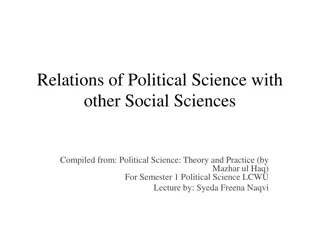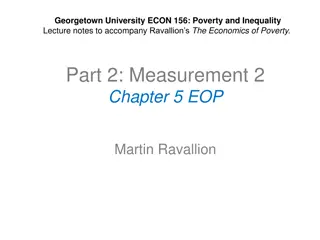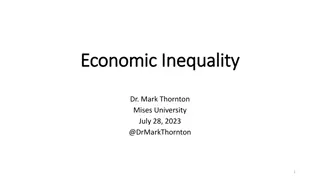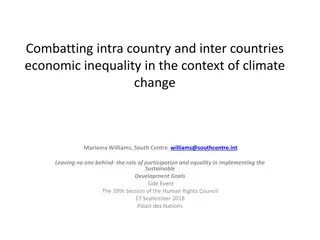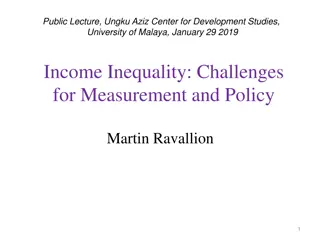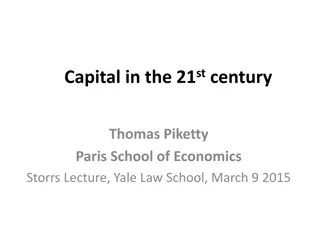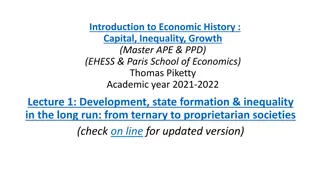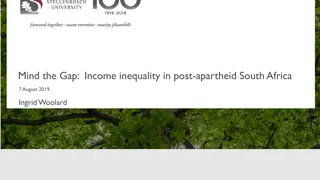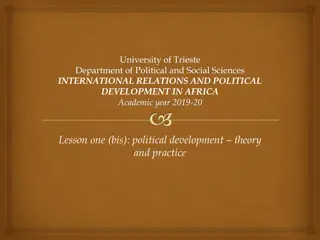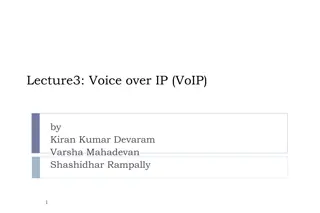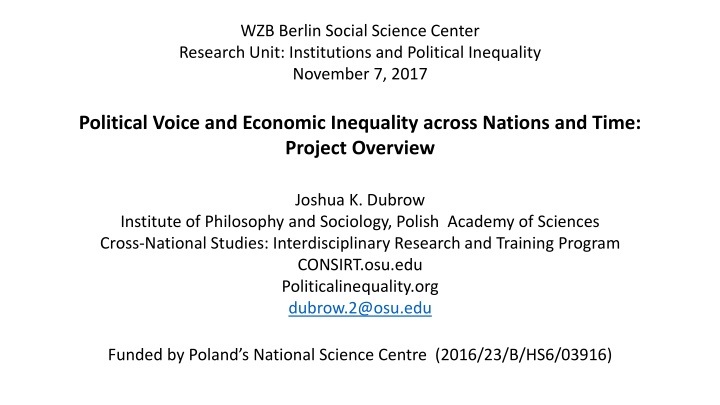
Political Voice and Economic Inequality Research Project
Project aims to advance theory, methods, and empirical base for studying relationship between political voice inequality and economic inequality across nations and time. Establishes a cross-national dataset of measures of political voice from survey and non-survey data for 65 countries worldwide spanning 1990-2015. Explores how political participation and party representation are related, the influence of economic inequality on political voice, and the extent of political inequality across countries and time.
Download Presentation

Please find below an Image/Link to download the presentation.
The content on the website is provided AS IS for your information and personal use only. It may not be sold, licensed, or shared on other websites without obtaining consent from the author. If you encounter any issues during the download, it is possible that the publisher has removed the file from their server.
You are allowed to download the files provided on this website for personal or commercial use, subject to the condition that they are used lawfully. All files are the property of their respective owners.
The content on the website is provided AS IS for your information and personal use only. It may not be sold, licensed, or shared on other websites without obtaining consent from the author.
E N D
Presentation Transcript
WZB Berlin Social Science Center Research Unit: Institutions and Political Inequality November 7, 2017 Political Voice and Economic Inequality across Nations and Time: Project Overview Joshua K. Dubrow Institute of Philosophy and Sociology, Polish Academy of Sciences Cross-National Studies: Interdisciplinary Research and Training Program CONSIRT.osu.edu Politicalinequality.org dubrow.2@osu.edu Funded by Poland s National Science Centre (2016/23/B/HS6/03916)
Over a 3-year period starting Autumn 2017, Project aims to: Advance the theory, methods, and empirical base for studying the relationship between political voice inequality and economic inequality across nations and time Create a cross-national dataset of measures of political voice from survey and non-survey data, for 65 countries worldwide spanning 1990 - 2015 Establish an international research team
Political inequality is... The existence of authority divisions Sorokin (1927) Structured differences in the distribution of political resources Lijphart (1997) When everybody s preferences are not equally weighted in political decisions Dahl and Lindblom (1953) Structured differences in influence over political decisions, and the outcomes of those decisions a synthesis
Political inequality is... A dimension of both democracy and stratification everywhere there is democracy, there is political inequality A phenomenon distinct from other inequalities (e.g. economic and social) and that relates to other inequalities An interdisciplinary subject
Political Inequality VOICE RESPONSE Participation Representation Policy Symbols
Political Inequality affluence and influence VOICE RESPONSE money in politics Participation Representation Policy Symbols socio-economic resources and voting, protest descriptive, party, SMOs and NGOs
Our main research questions: (1) How, and to what extent, are political participation and party representation related to each other once main features of political and economic institutions are accounted for? (2) How and to what extent does economic inequality as a macro characteristic influence political voice at the individual level? (3) Across countries and time, how and to what extent do political voice inequality and economic inequality influence each other?
Macro-level Indicators of Political Voice (A)Levels of Voice e.g. Proportion of political participation in a country-year (B) Inequality of Voice e.g. Ratio of participation for different groups, Gini, etc. in a country- year
Effects of V on E Institutions Effects of E on V Institutions Political Participation (P) Economic Inequality (E) Economic Inequality (E) VOICE (V) Party Representation (R) Institutions
Economic Inequality and Political Voice Economic resources: Directly impact institutional and non-institutional forms of political participation (e.g. Verba et al 1995, Teorell 2006; Marien et al 2010) through capacities and incentives. Impact party representation through other mechanisms, e.g. descriptive representation (Mansbridge 1999), money-in-politics (APSA Task Force 2004), and affluence & influence (e.g. Bartels 2008, Gilens 2012). Inequalities of all kinds economic, political, social link together. Economic inequality opens gaps between social groups in access to political decisions, which can deepen political voice inequality across society, and for some groups in particular.
Economic Inequality and Political Voice Cross-national empirical literature on the relationship between economic inequality and democracy dates back a long way, e.g. Meltzer and Richard 1981, Acemoglu and Robinson 1999, Gradstein and Milanovic 2004, Timmons 2010. Democracy is system of political power that allows for citizens to have a substantial say in how society should function. Democracy depends in large part on the character of its institutions.
Economic Inequality and Political Voice What is the role of institutions? Some possibilities: Trade Unions are organized interest groups that moderate the relationship between labor and capital it can amplify voice, and possibly reduce income inequality. Corruption is a characteristic of political and economic institutions - some find that it is associated with income inequality and participation. Multiple access points to political decisions can encourage voice (Solt 2008): Presidentialism, separation of powers between the executive and legislative branches; Federalism, in which the considerations of country regions are taken into account, and they have a say in how the whole society should be run.
Economic Inequality and Political Voice Cross-national empirical studies of economic inequality (macro) and political participation (micro) test classic theories: Grievance theory: the maldistribution of economic resources incites participation: the higher the level of economic inequality, the greater the political participation of the disadvantaged. Resource theory: because economic resources are crucial to political participation, unequal economic distribution lowers the probability of political participation for everyone except for the economically privileged. Economic inequality Lowers the probability of political participation for the disadvantaged (e.g. Solt 2008, 2015) Has no relationship with political participation (e.g. Dalton et al 2010)
Economic Inequality and Political Voice Cross-national empirical studies of economic inequality (macro) and party representation (micro) are even more recent and rely on the affluence & influence mechanisms, i.e. the economically advantaged influence the ideologies of parties: Rosset et al 2017 found that economic inequality skews party representation measured as issue congruence away from the disadvantaged, i.e. the ideological composition of parties in government are less similar to the disadvantaged. This could be a long-term problem: Keman (2011) finds that, In spite of large electoral changes since the 1990s, party composition of government changes less and established parties stay longer in office than others regardless their electoral fortunes.
Relationship between Voice Inequalities of Political Participation and Party Representation How and to what extent are political participation and party representation related? What forms of political participation relate to party representation? e.g. o Group voting should have an impact on the ideological diversity of parties in government o But do non-institutional forms of participation influence the ideological diversity of these parties? How does party representation relate to political participation?
Effects of V on E Institutions Effects of E on V Institutions Political Participation (P) Economic Inequality (E) Economic Inequality (E) VOICE (V) Party Representation (R) Institutions
Measurement Considerations Time span of analysis: 1990s to 2015 Thinking cross-national: Functional equivalence, and the data situation varies by country Thinking across time: To account for lag effects in the relationship between economic and political inequalities Levels of Voice and Inequalities of Voice Combining measures of political participation and party representation
Some issues in measuring voice in terms of... Political Participation Forms of Participation: Institutional (voting, membership or working in a party, contacting a politician) and Non-institutional (signing a petition, attending a demonstration, political consumerism) As a Macro Measure: -- Inequality between whom? Between those who participate and those who do not? By degree of participation? Can we measure the political inequality of voice of a whole society by what proportion participates and what proportion does not? -- Participation by subgroups, e.g. Socio-economic (income, education, class), Social (gender, age, ethnicity), Political values (political ideologies, role of government in society) and so on.
Some issues in measuring voice in terms of... Party Representation Most cross-national studies on party representation focus on issue/ideological congruence using left-right scales (Golder and Stramski 2010), but there are considerable problems with: o Limited data availability (e.g. best cross-national data are Comparative Study of Electoral Systems and the PRIEDEU project) o Questions about the validity of left/right scales (e.g. Budge 2000) Alternatively, we can focus on the difference between the diversity of the parties in government and the diversity of peoples party preferences (that feel close to or voted for a party, as revealed in surveys).
Years Covered Concept Dataset Countries Economic Inequality Standardized World Income Inequality Database SWIID 100 + 1960 - 2013 Political Voice: Levels and Inequalities Political Participation The Harmonization Dataset 120 + 1966 - 2013 Party Representation (a) Party preferences 50 + 1990 - 2014 World Values Survey (b) Parties in and out of government International Parliamentarian Union 150 + 1945 - 2016 Institutional Characteristics Character of political institutions Quality of Government (QoG) 100 + 1990 - 2015 Level of democracy Freedom House, Polity IV, and V-Dem 150 + 1990 - 2015
The Harmonization Dataset (formally, the SDR Database V.1) This is a multi-country multi-years data set for comparative, cross-national research on Democracy and Political Participation. It has ex post harmonized survey data for 22 international survey projects: Asian Barometer Afrobarometer Americas Barometer Arab Barometer Asia Europe Survey Caucasus Barometer Consolidation of Democracy Comparative National Elections Project Eurobarometer European Quality of Life Survey European Social Survey European Values Study International Social Justice Project International Social Survey Programme Latinobarometro Life in Transition Survey New Baltic Barometer Political Action II Political Action - An Eight Nation Study Political Participation and Equality Values and Political Change World Values Survey 89 waves (i.e. project*wave) and 1,721 national surveys (i.e. project*wave*countries); 142 countries/territories, from 1966 to 2013. N= 2, 289,060 respondents. The database & documentation are available via Harvard dataverse (see also: dataharmonization.org)
Geographical coverage before and after Geographical coverage before and after ex post ex post survey data harmonization survey data harmonization b. Harmonization Database V.1 1966-2013 (n total = 1,721 national surveys) WVS/EVS 1981-2009 (n total = 321 national surveys)
Variables in the Harmonization Database - Survey variables (individual level) Political attitudes and behaviors Trust in the national parliament Trust in the justice system Trust in political parties Trust in the government Participation in demonstrations: 1.Referring to actual past participation: 0 for no participation , 1 for participation 2.Referring to potential participation: 0 for would never participate , 1 for would participate Signing petitions: 0 for no participation , 1 for participation Interest in politics
Variables in the Harmonization Database - Survey variables (individual level) Socio-demographics Gender (female = 1) Age - in years (derived from year of birth where available) Year of birth (derived from interview year and age, where no year of birth available) Rural/urban - residence of the respondent; rural = 1, otherwise = 0 Education (levels) - adapted ISCED scale; 0 - less than primary; 8 doctoral or equivalent Schooling years - calculated from age at completion of education if schooling years not available; 0 = no formal education, 18 = 18 years of schooling or more (topcoded)
Variables in the Harmonization Database - Country-year-level variables (macro indicators) GDP per capita Freedom House ratings Population size Percent urban population Population of largest city Proportion of women in parliament Worldwide Governance Indicators EIU Democracy Index Gini index (Milanovic and Solt) Available for all countries that appear in the Harmonization Database, starting in 1945, and depending on the availability of the given measure (per country-year).
Current Status and Future Activities Hiring PhD students and a post-doc (Autumn 2017) Assembling an Advisory Board (Autumn 2017 Spring 2018) Creating reports on concepts, theory, and measures (2018 - 2020) Analyses, presentations, writing articles (2018 - 2020) Workshops (2018, 2019, 2020) and Conference (2020)
Structure of the SDR Database The SDR database is a relational database whose core is the MASTER file with harmonized survey data. Additional files (tables) contain information describing the survey process, various metadata and contextual data from publicly available sources (e.g., GDP). Corresponding to their respective level of measurement, these additional data are stored in different Plug- files. The Plug- files are linked to the Master file by one or more key variables in the form of one-to-many merges. Each data file is accompanied by a technical report detailing sources and data construction.
Variables in the SDR Database - Survey variables (individual level) Technical variables Interview date - date of the interview (where available) Interview year - year of the interview (where available) Survey year - uniform within national survey (or when the majority of interviews were conducted) Country - country or territory (Germany: DE-E & DE-W, Israel: IL-JEW & IL-ARB, etc.) Weight - individual case weight: design, poststratification or combined weights, as provided in the original survey data set (where available, otherwise = 1)
Political Inequality VOICE RESPONSE Participation Representation Policy Symbols
Political Inequality RESPONSE VOICE Participation Representation Policy Symbols
Our main research questions (1) How and to what extent are main components of political voice inequality political participation and party representation related to each other once main features of political and economic institutions are accounted for? (2) Across countries and time, how and to what extent do political voice inequality and economic inequality influence each other?
Main research questions Deal with: (1) The relation between political participation and party representation, as two main components of inequality of voice (2) The relation between economic inequality, as a macro characteristic, and political voice at the individual level (3) The relation between political voice inequality and economic inequality across countries and time
Macro-level Indicators of Political Voice (A)Levels of Voice e.g. Proportion of political participation in a country-year (B) Inequality of Voice e.g. Ratio of participation for different groups, Gini, etc. in a country- year





